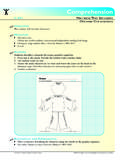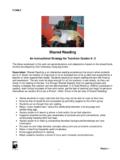Transcription of GSE Effective Instructional Practices Guide - Official Site
1 GSE Effective Instructional Practices Guide Three Act Tasks Formative Instructional Practices Number Talks Mathematics Georgia Department of Education Effective Instructional Practices Guide Mathematics Effective Instructional Practices Richard Woods, State School Superintendent Contents: Three-Act Task Guide .. 3 Formative Instructional Practices .. 10 Number Talks .. 11 Georgia Department of Education Effective Instructional Practices Guide Mathematics Effective Instructional Practices Richard Woods, State School Superintendent Three-Act Task Guide Purpose: GENERAL DESCRIPTION A Three-Act Task is a whole group mathematics task consisting of 3 distinct parts: an engaging and perplexing Act One, an information and solution seeking Act Two, and a solution discussion and solution revealing Act Three.
2 WHEN AND WHY IS THIS USEFUL? WHAT CAN STUDENTS LEARN FROM THIS EXPERIENCE? A Three-Act Task is useful: To provide an engaging context for the use of mathematics and the development of mathematical understanding. To reduce the literacy demand To add engagement. Students wonder what will happen next. To create low barriers to entry, allowing the teacher to scaffold as necessary To provide an opportunity for estimation and reasonableness To provide opportunities to talk about mathematics To provide opportunities for reflective thought To build new knowledge from prior knowledge To encourage multiple approaches To honor diversity To create situations which require students to engage in mathematical modeling To build relational understandings among mathematics concepts To shift student ideas about justification of Development of critical thinking skills How to make sense of problems and persevere in solving them How to reason abstractly and quantitatively How to construct viable arguments and critique reasoning
3 How to model with mathematics How to choose and use tools strategically How to look for and make use of structure How to look for and express regularity in repeated reasoning How to justify thinking and answers (rather than relying on a teacher or answer key for validation of correctness) Creation of connections among mathematical concepts (relational understanding) Georgia Department of Education Effective Instructional Practices Guide Mathematics Effective Instructional Practices Richard Woods, State School Superintendent thinking and answers Why 3-Acts? A teacher shares his thinking (from: ) Why use 3-Act Tasks? A Teacher s Response: The short answer: It's what's best for kids! If you want more, read on: The need for students to make sense of problems can be addressed through tasks like these.
4 The challenge for teachers is, to quote Dan Meyer, be less helpful. (To clarify, being less helpful means to first allow students to generate questions they have about the picture or video they see in the first act, then give them information as they ask for it in act 2.) Less helpful does not mean give these tasks to students blindly, without support of any kind! This entire process will likely cause some anxiety (for all). When jumping into 3-Act tasks for the first (second, third, ..) time, students may not generate the suggested question. As a matter of fact, in this task about proportions and scale, students may ask many questions that are curious questions, but have nothing to do with the mathematics you want them to investigate. One question might be How is that ball moving by itself?
5 It s important to record these and all other questions generated by students. This validates students' ideas. Over time, students will become accustomed to the routine of 3-act tasks and come to appreciate that there are certain kinds of mathematically answerable questions most often related to quantity or measurement. These kinds of tasks take time, practice and patience. When presented with options to use problems like this with students, the easy thing for teachers to do is to set them aside for any number of "reasons." I've highlighted a few common "reasons" below with my commentary (in blue): This will take too long. I have a lot of content to cover. (Teaching students to think and reason is embedded in mathematical content at all levels - how can you not take this time) They need to be taught the skills first, then maybe I ll try it.
6 (An important part of learning mathematics lies in productive struggle and learning to persevere [SMP 1]. What better way to discern what students know and are able to do than with a mathematical context [problem] that lets them show you, based on the knowledge they already have - prior to any new information. To quote John Van de Walle, Believe in kids and they will, flat out, amaze you! ) My students can t do this. (Remember, whether you think they can or they can t, you re right!) (Also, this expectation of students persevering and solving problems is in every state's standards - and was there even before common core!) I'm giving up some control. (Yes, and this is a bit scary. You're empowering students to think and take charge of their learning.)
7 So, what can you do to make this less scary? Do what we expect students to do: o Persevere. Keep trying these and other open-beginning, -middle and -ended problems. Take note of what's working and focus on it! o Talk with a colleague (work with a partner). Find that critical friend at school, another school, online.. o Question (use #MTBoS on Twitter, or blogs, or Google: 3-act tasks). Georgia Department of Education Effective Instructional Practices Guide Mathematics Effective Instructional Practices Richard Woods, State School Superintendent The benefits of students learning to question, persevere, problem solve, and reason mathematically far outweigh any of the reasons (read excuses) above. The time spent up front, teaching through tasks such as these and other open problems creates a huge pay-off later on.
8 However, it is important to note, that the problems themselves are worth nothing without teachers setting the expectation that students: question, persevere, problem solve, and reason mathematically on a daily basis. Expecting these from students, and facilitating the training of how to do this consistently and with fidelity is principal to success for both students and teachers. Yes, all of this takes time. For most of my classes, mid to late September (we start school at the beginning of August) is when students start to become comfortable with what problem solving really is. It's not word problems - mostly. It's not the problem set you do after the skill practice in the textbook. Problem solving is what you do when you don't know what to do! This is difficult to teach kids and it does take time.
9 But it is worth it! More on this in a future blog! Tips: One strategy I've found that really helps students generate questions is to allow them to talk to their peers about what they notice and wonder first (Act 1). Students of all ages will be more likely to share once they have shared and tested their ideas with their peers. This does take time. As you do more of these types of problems, students will become familiar with the format and their comfort level may allow you to cut the amount of peer sharing time down before group sharing. What do you do if they don t generate the question suggested? Well, there are several ways that this can be handled. If students generate a similar question, use it. Allowing students to struggle through their question and ask for information is one of the big ideas here.
10 Sometimes, students realize that they may need to solve a different problem before they can actually find what they want. If students are way off, in their questions, teachers can direct students, carefully, by saying something like: You all have generated some interesting questions. I m not sure how many we can answer in this class. Do you think there s a question we could find that would allow us to use our knowledge of mathematics to find the answer to (insert quantity or measurement)? Or, if they are really struggling, you can, again carefully, say You know, I gave this problem to a class last year (or class, period, etc) and they asked (insert something similar to the suggested question here). What do you think about that? Be sure to allow students to share their thoughts.
















